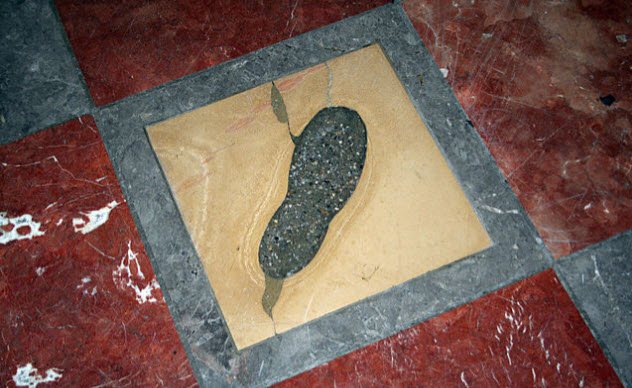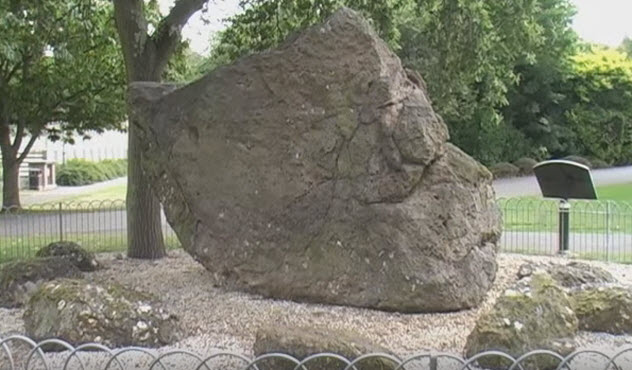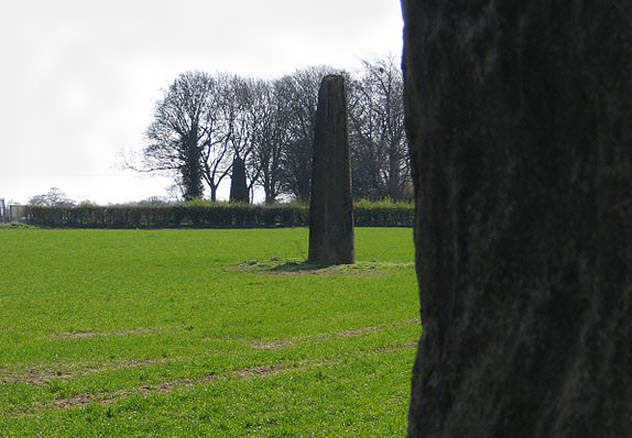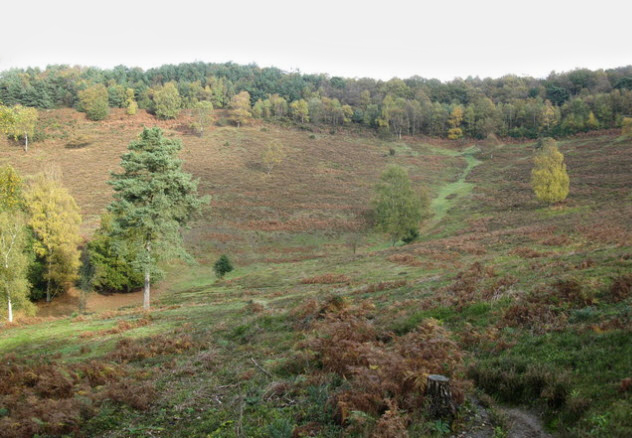 Creepy
Creepy  Creepy
Creepy  Movies and TV
Movies and TV 10 Movies That Get Elite Jobs Right, According to Experts
 Weird Stuff
Weird Stuff 10 Times Real Laws Were Based on Bizarre Hypotheticals
 Animals
Animals 10 Inspiring Tales of Horses Being Human
 Mysteries
Mysteries Top 10 Haunting Facts About the Ghost Ship MV Alta
 History
History 10 Surprising Stories About the Texas Rangers
 Humans
Humans 10 Philosophers Who Were Driven Mad by Their Own Theories
 Miscellaneous
Miscellaneous 10 Video-Game-Worthy Weapons and Armors from History
 Weird Stuff
Weird Stuff 10 Psychics Who Accurately Predicted Wartime Events
 The Arts
The Arts 10 Pieces of Art Inspired by a Broken Heart
 Creepy
Creepy 10 Death Superstitions That Will Give You the Creeps
 Movies and TV
Movies and TV 10 Movies That Get Elite Jobs Right, According to Experts
 Weird Stuff
Weird Stuff 10 Times Real Laws Were Based on Bizarre Hypotheticals
Who's Behind Listverse?

Jamie Frater
Head Editor
Jamie founded Listverse due to an insatiable desire to share fascinating, obscure, and bizarre facts. He has been a guest speaker on numerous national radio and television stations and is a five time published author.
More About Us Animals
Animals 10 Inspiring Tales of Horses Being Human
 Mysteries
Mysteries Top 10 Haunting Facts About the Ghost Ship MV Alta
 History
History 10 Surprising Stories About the Texas Rangers
 Humans
Humans 10 Philosophers Who Were Driven Mad by Their Own Theories
 Miscellaneous
Miscellaneous 10 Video-Game-Worthy Weapons and Armors from History
 Weird Stuff
Weird Stuff 10 Psychics Who Accurately Predicted Wartime Events
 The Arts
The Arts 10 Pieces of Art Inspired by a Broken Heart
10 Marks Supposedly Left On Earth By The Devil
Humans are renowned for being able to spot patterns where there are none and see images in random shapes and patterns. It’s kept us occupied for countless lazy Sunday afternoons, picking out the shapes of animals and dragons in the clouds.
It’s also helped us enrich our legends and folklore around the world, making us see footprints where we know there shouldn’t be any and helping us build stories around phenomena that are often spectacular in their own right.
10 Der Teufelstritt
Germany

The silhouette of the Church of Our Lady is unmistakable against the Munich skyline. While most might sing the praises of its 14th-century windows or its 18th-century gilded reliefs, a more interesting feature is the so-called “devil’s footprint.”
Church architect Jorg von Halsbach first showed up in Munich’s city records in 1441. He was appointed the architect to the entire city in 1468. In that role, he oversaw many other architects, but the Church of Our Lady is still considered one of his masterpieces.
According to legend, he got a little otherworldly help when he made an agreement with the Devil. Funding was difficult to come by, and if von Halsbach agreed to make the church a dark, windowless monument to the night, the Devil would pay for it.
The agreement was signed and sealed. When the building was finished, it was time to deliver. The architect escorted the Devil inside to prove that the bargain had been upheld. From where they stood, there were no windows visible, and the Devil declared that von Halsbach’s side of the bargain had been completed.
When the Devil took another step forward, though, he saw windows that had been hidden behind the church’s massive interior columns. He promptly threw a temper tantrum. When he stamped his foot, his footprint stayed in the church floor.
It’s a great story. But there is no supporting evidence for this fanciful tale, and it’s generally accepted that the footprint wasn’t always there. The tile with the footprint doesn’t seem to match anything else. It was probably installed during restorations that took place as late as the years following World War II.
The story may date back as far as the 17th century when the large window at the end of the church was blocked by an altar. Perhaps the tile was added afterward in support of the story.
9 The Devil’s Tramping Ground
US
The Devil might go down to Georgia, but according to some centuries-old folklore, he comes out in North Carolina. Down a country road in Chatham County is a barren, 12-meter (40 ft) circle that’s been given the nickname “The Devil’s Tramping Ground.”
Every night at midnight, it’s said that the Devil comes out and stomps around there in a circle, planning the night’s activities before heading off to do his work. People have tried to grow plants there, but they die. Supposedly, any objects left within the circle during the day will be thrown out overnight.
Other ideas to explain the circle are mostly of the extraterrestrial and paranormal variety. Locals have often used the place as a meeting spot for parties, but some testify that they’ve failed spectacularly in their attempts to spend the night there. They cite a rather creepy feeling as the reason.
Scientists have tried to figure out why nothing will grow in this weird spot, but they’re stumped. Soil scientist Rich Hayes first thought that the copper or salt content of the soil was the reason. Although none of his tests were conclusive, they did reveal that there was something odd about the circle.
The barren soil within the circle had a higher pH level and higher concentrations of zinc, sodium, and copper than the ground outside the circle. The readings weren’t high enough to prevent things from growing, though.
Campfires built at this party spot might explain some of Hayes’s readings, but they don’t account for stories about the circle that go back hundreds of years. Strangely, compasses can also be thrown off by a few degrees when you’re walking through the circle. No one can explain that, either. So far, it’s added up to a big mystery for science.
8 The Goldstone
England

The Goldstone got its name from the fact that it’s a stone with some gold flecks in it. While that’s fairly unimaginative, the folklore about the rock is much more impressive.
The stone that now sits as a centerpiece in Hove Park was reportedly first unearthed by the Devil. When he was digging a trench through the area—with the goal of channeling the water to flood all the local churches—he stubbed his toe on the massive Goldstone. Furious, the Devil kicked the Goldstone as far as he could. It landed in what’s now called Goldstone Valley, but that’s not the end of the trouble it caused.
By the beginning of the 19th century, there were more tales told about the Goldstone. According to local legends, the rock had been sacred to the druids, who once worshiped their mysterious deities in ancient Britain.
That sparked massive interest in the stone. As the stories spread, curiosity seekers flocked from all over to see it. But the Goldstone was in the middle of a farmer’s field. He was sick of his crops being destroyed by determined yet thoughtless intruders.
So landowner William Marsh Rigden buried the stone along with a series of smaller—yet still sizable—surrounding stones. The location of the buried stones was discovered in 1900. They were unearthed and moved to Hove Park.
Even then, the Goldstone continued to attract its share of folklore. On one side of the stone is a naturally weathered pattern that looks a bit like a human face. That gave rise to the story about the Devil’s run-in with the massive stone. In 1858, the stone was called the “Godstone” on a Brighton map. The stone was also at the center of a commemoration of some local druidic chapters in 1929.
7 Purgatory Falls
US
The Purgatory Brook Falls isn’t far from Mont Vernon, New Hampshire. It’s a weirdly secluded location that seems like it should be surrounded by the same hustle and bustle you’ll find on the major highways that go past the area.
Starting in the early 1800s, it was the source of water power for all the area lumber mills until a massive fire destroyed many of them in 1950. Appropriate, perhaps, considering the lore behind several of the formations along the falls.
Throughout the 1800s, the upper falls was a popular party spot. There are some records of a hotel on the grounds, and others claim that a picnic area and pavilion were there. An overlook into a deep hole in the rocks has been given the odd name of the Devil’s Bean Pot.
According to the legend, the Devil once set his sights on the townspeople of Mont Vernon. He told them that he was going to cook them a huge dinner with everything you might expect from a gourmet meal. He was cooking the beans in the hole in the rock, but when he grabbed the cauldron, he burned himself.
The Devil flew into a rage that revealed his true nature to the revelers. They fled as he blistered the nearby rock with the heat from his fire, leaving behind an imprint of his foot.
Supposedly, anyone brave enough to climb into the Devil’s Bean Pot will find names and dates carved into the rock. Perhaps these are the names of people bribed by the Devil with his tasty dinners.
6 Djavolja Varos
Serbia
Sitting in the southern part of Serbia near Mount Radan is Djavolja Varos, a national monument and epic landscape whose name can be translated as “Devil’s Town.” The landscape has eroded into 202 tall spires of rocks—some of which appear to be wearing little hats—because of the unique composition and high mineral content of the soil.
Those hats were actually the product of a volcanic eruption that happened millions of years ago. But even with a perfectly reasonable, scientific explanation for the land’s strange appearance, interesting legends have arisen over the years.
According to one legend, the Devil was once so greatly annoyed by the good, religious, humble people who lived in the area that he cursed the drinking water to make them forget who was related to whom.
That led to one of the greatest affronts to the religious and natural order of things: the marriage of a couple who were brother and sister. A good fairy intervened on the part of the town and prayed for an end to the relationship. As a result, the entire wedding party was turned to stone.
The water that the townspeople drank is still there in the form of two springs called the Devil’s Water and the Red Well. Depending on the rains and due to the mineral-rich soil, the springs yield water that is up to 1,000 times richer in minerals than the waters of nearby springs. The high iron content has turned the riverbed red.
There are a handful of other tales that supposedly explain the rock formations, and they all have a hellish bent. Some say that the stone columns are devils, trapped by some clever boys from a nearby village. Others say that the columns are the remains of a church or churches that were destroyed by demons.
5 Martense Lane Rock
US
A boulder in Brooklyn marks the site of a road from the Revolutionary War called Martense Lane. At the time, it was the only road running east to west in the area. The boulder was moved there fairly recently from the sidewalk of the Basilica of Our Lady of Perpetual Help 25 blocks away.
The rock was left over from some repairs to the street. When the huge stone was moved, people noticed a strange mark on it that looked like a footprint. Admittedly, that discovery was odd because there just happens to be a legend about the Devil, a footprint, and a rock along Martense Lane.
According to legend, a slave named Joost was heading home after playing his fiddle at a Flatbush wedding. He was rather drunk and sat down on a rock along Martense Lane to try to get the world to stop spinning.
Then he picked up his fiddle and started to play. As he played, a bell rang, signaling midnight and his sin of playing an instrument on the Sabbath. Figuring that he’d already sinned and had nothing more to lose, he continued to play his song. When he finished, there was a stranger standing next to him.
The stranger said that he knew the song and that it was called “The Devil’s Joy at Sabbath Breaking.” They bickered and eventually began a contest to see who played better.
The competition lasted until dawn. When Joost played a hymn, the Devil declared that he had been beaten. After stamping his foot on the rock where Joost had been sitting, the Devil disappeared. But he left behind a footprint that gave credence to Joost’s story whenever he told it.
4 The Devil’s Arrows
England

Britain is quite literally covered with all kinds of standing stones—from menhirs and megaliths to dolmens, court cairns, and wedge tombs. Although they’re all impressive, the three standing stones that remain at Boroughbridge are among the tallest of any kind. The southernmost stone stands at 7 meters (23 ft) tall.
With the other two stones at about the same height, it’s safe to assume that the missing fourth stone was that tall, too. In 1621, the fourth stone was broken into pieces and used to build a bridge. The upper piece still sits in Aldborough Manor.
Known as the Devil’s Arrows, the standing stones at Boroughbridge are believed to be part of a much larger, prehistoric complex that hasn’t been excavated or mapped yet.
While these stones were undoubtedly of major importance when they were erected, their original purpose is no longer known. Popular legend says that the Devil was standing on nearby How Hill when he was offended by the village of Aldborough.
The legend doesn’t identify the offense, but it made the Devil angry enough to lob several arrows in the direction of the village. He missed by about 1.5 kilometers (1 mi), which shows how weak his throwing arm was or how bad his aim was.
It’s still said that walking around the stones 12 times in a counterclockwise direction will call the Devil back. It’s also been suggested that the positioning of the stones has something to do with the area’s ley lines.
Curious people have been trying to unlock the mysteries of the stones for generations. The first recorded excavation of the site took place in 1709. It was discovered that the central stone extended for another 1.5 meters (5 ft) and had a man-made flat bottom.
3 The Devil’s Footprint
US
In Manchester, Maine, a rock exists that is said to have the footprint of the Devil on it. Supposedly, all attempts to chisel away the footprint have been unsuccessful. Nothing has been able to damage it.
The rock is now part of a wall around a cemetery near the Manchester Meeting House. Although a couple of different stories explain how the footprint got there, it’s generally agreed that there is ghostly activity around the rock. In fact, there are claims that cars tend to break down when they’re nearby.
According to one of the stories, the rock was uncovered when a team of construction workers were building a new road. They were unable to move the rock—even using all their equipment and some dynamite.
It wasn’t long before the workers had had enough. One worker made an incredibly unwise proclamation: He would give his soul to the Devil if the Devil would just move the blasted rock. Then the workers headed home for the night.
When they returned the next day, the rock had been moved several yards away to its current location. There were also imprints on the rock which looked like the impressions of a human foot and the three-toed foot of the Devil. As for the man who had made the promise, he was never seen nor heard from again.
According to another story, a local farmer who needed a good harvest to pay off his debts promised his soul to the Devil if the Devil could make it happen. The harvest came in, and the debts were paid.
But when the Devil came to collect the soul he’d been promised, the farmer fled to the top of a nearby building. The Devil gave chase, and both he and the farmer jumped off the roof of the building. Their footprints were imprinted into the rock, and presumably, the farmer learned that he should never have made a deal with the Devil.
2 Teufelsbrucke
Switzerland
There are a surprising number of so-called Devil’s bridges scattered across Europe. Many of the stories are similar. They involve a location that’s too difficult for human builders, so they turn to the Devil to get the work done. In most cases, it’s a fun way to explain how these feats of engineering were completed. Even so, the bridge at Teufelsbrucke is a little different.
The bridge crosses the Schollenen Gorge, which was the shortest route to St. Gotthard Pass. But it was a dangerous shortcut. It wasn’t until 1230 that the first bridge was built across the chasm, a godsend for shepherds and a nightmare for the builders who had to make their way across the raging Reuss River.
Desperate for the shortcut, legend says that a Swiss goatherd made a deal with the Devil. In exchange for building the bridge, the Devil would earn the right to claim the first soul that crossed it. Conditions were agreed upon, the Devil built the bridge, and the goatherd sent across one of his goats.
The Devil was so outraged at the trick that he picked up a massive boulder and prepared to smash the bridge he’d built. But hell hath no fury like a little old lady on a mission. When the Devil met one with a crucifix, he abandoned his plans and hightailed it back to Hell, dropping his rock. There’s no mention of whether he took the goat with him, but we like to think the little creature got away.
Several bridges have been built across the gorge, including a stone bridge in the 16th century and a replacement in 1820. The story of the Devil’s participation in building the original bridge has persisted, helped by the presence of a 220-ton rock that was supposedly dropped by the Devil.
According to some people, that rock is still causing trouble. In 1977, the rock was moved to make way for a new road. Some people blamed that move for a suspicious rise in the number of car accidents in the area.
1 The Devil’s Punch Bowl
England

The Devil’s Punch Bowl is a dry hollow nestled in southern England. Scientifically, this geographic anomaly was caused by erosion that was stopped by a layer of clay soil. But there are a couple of other explanations that are far more fun.
The area isn’t far from Thursley (aka Thor’s Lie), a residence of the Norse god Thor. The Devil lived at the aptly named Devil’s Jumps outside Churt, and he was more than close enough to Thor to be a real pest.
While the Devil jumped between the hills, Thor tried to hit him with his thunder and lightning. In response, the Devil scooped up mounds of earth to throw back at Thor, and what was left became the Devil’s Punch Bowl. Another version of the story has Thor scooping out the handfuls of earth and throwing them at the Devil.
A third story featured the Devil trying to dig a trench to flood England’s churches. As he dug the aptly named Devil’s Dyke in West Sussex, he disturbed a rooster. When the rooster crowed, the Devil thought it was morning and fled for the safety of the Devil’s Punch Bowl. With his trench unfinished, the churches were safe from his hellish machinations for another day.








